When the #21312 LEGO Ideas Women of NASA set became available at the beginning of the month, I purchased it right away from the Online LEGO Shop. I didn’t want to end up missing out like with the #21110 LEGO Ideas Research Institute in 2014, which sold out within hours after initial release. (I was eventually able to get the LEGO Ideas Research Institute, but only by the kindness of a fellow LEGO fan via the Brickset Forum.) The LEGO Ideas Women of NASA set arrived in the mail a couple of days ago, and I immediately set down to build it. 🙂
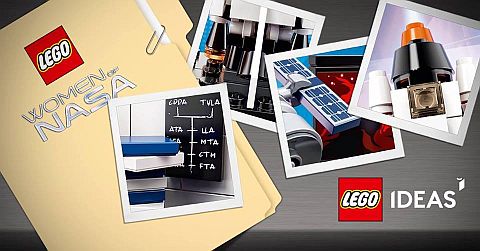
The #21110 LEGO Ideas Research Institute and the #21312 LEGO Ideas Women of NASA are actually similar in more than one way. Both sets include three small vignettes highlighting women in scientific fields, both have been immensely popular even outside of the LEGO fan community, and both are somewhat controversial with LEGO fans. And, both are fast sellers.
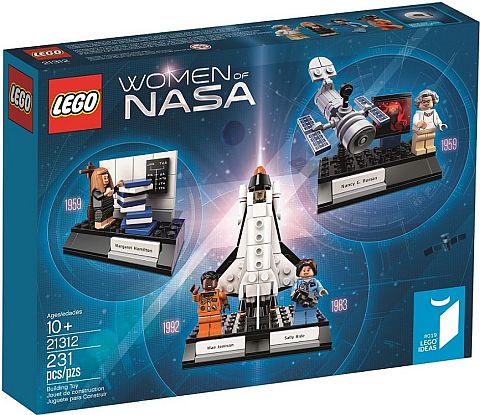
Based on the pictures I have seen online, I was expecting the #21312 LEGO Ideas Women of NASA to come in the same size box as the #21110 LEGO Ideas Research Institute, but it is actually a bit larger (same as the #21109 LEGO Ideas Exo-Suit box), and comes with 96 more pieces and 1 additional minifigures compared to the Research Institute.
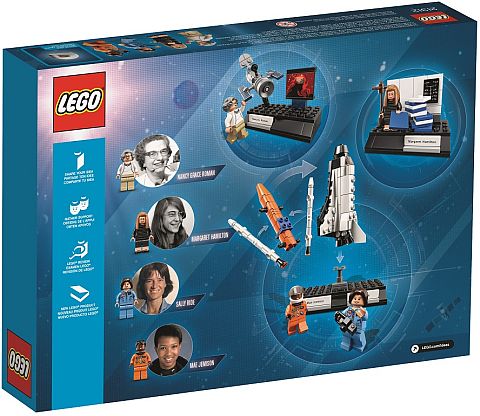
The box is the standard higher quality packaging with a flip-up lid that LEGO Ideas sets are known for. I really like these boxes, as they double as storage containers both for the loose pieces while building, and for storing the finished set.
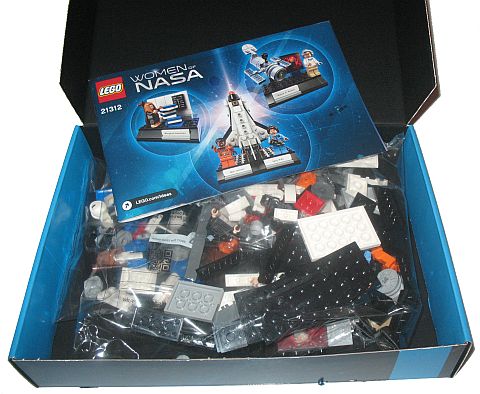
The instruction booklet is 79 pages and includes a brief bio for all four women featured in the set (one page for each), as well as a couple of pages about the fan designer, Maia Winstock, who originally submitted the project to LEGO Ideas, and LEGO designers Gemma Anderson and Marie Sertillanges, who finalized the project for production. While the graphics and information in the booklet are very nice, the paper quality significantly deteriorated compared to previous LEGO Ideas sets. The paper is flimsy and thin, the same you find in regular LEGO sets. I’m not so happy about this.
➡ LEGO IDEAS WOMEN OF NASA – MARGARET HAMILTON: According to the booklet, Margaret was born in 1936, and was always interested in mathematics. Her early work, beginning in 1959, included developing weather predicting and air-defense software at MIT, in an era when computer science and software engineering were not yet established disciplines. When NASA contracted with MIT to develop the guidance and navigation system for its Apollo Moon-landing program, Hamilton’s experience led to her becoming the leader of the team responsible for developing the spacecraft’s on-board flight software for the command module and the lunar module. Hamilton is now CEO of Hamilton Technologies, and for her work as a pioneering computer scientist, she received NASA’s Exceptional Space Act Award in 2003, and the Presidential Medal of Freedom from President Obama in 2016. In other words, she is awesome.
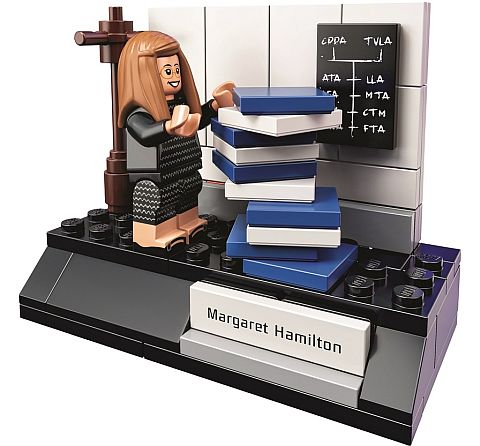
The little LEGO vignette for Margaret features a stack of books, representing the books of listings of Apollo Guidance Computer (AGC) onboard flight software source code. Behind her, there is a whiteboard and a coat hanger, which are both authentic details from her real life picture. The writing on the chalkboard and her nameplate are printed pieces. The minifig version of Margaret is extremely detailed with printing at both the front and back of her torso, the front and side of her legs, and her shoes are also printed. She comes with a double sided face with an open and close mouthed smile, and I’m especially impressed by how well her facial features match her photograph. All in all, a simple little diorama that captures the character nicely, but there are not a whole lot of play-features.
➡ LEGO IDEAS WOMEN OF NASA – SALLY RIDE: Sally Ride was born in Los Angeles in 1951. While completing her PhD in physics at Stanford University, she read in a student newspaper that NASA was recruiting astronauts, and for the first time, women could apply. Sally was one of 8,000 applicants and one of six women selected by NASA in 1978. While training for her first spaceflight, she endured intense media attention focused on her gender, but she insisted on being treated like any other astronaut. In 1983, she blasted off aboard the Challenger to become America’s first woman in space, and then flew again on the Challenger in 1984. After retiring from NASA, she became a physics professor and inspired young people in math and science. She passed away in 2012, and was posthumously awarded the Presidential Medal of Freedom.
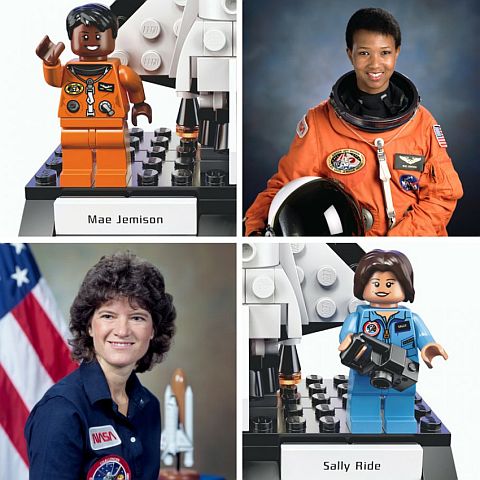
➡ LEGO IDEAS WOMEN OF NASA – MAE JEMISON: Mae started Stanford University at the age of 16, and graduated with Bachelor’s degrees in Chemical Engineering and African Studies. She then earned her doctorate in Medicine from Cornell University Medical College. She practiced medicine and lived in West Africa as the Area Peace Corps Medical Officer for Sierra Leone and Liberia. In 1987, she was one of the 15 individuals chosen from among 2000 applicants to train to be a NASA astronaut. In 1992, she launched into space aboard the Endeavour, spending over 190 hours conducting life sciences, material sciences and medical experiments. Traveling over three million miles, Mae was the first women of color in the world in space. Since then, Mae founded an international science camp for kids, taught environmental studies, and is leading a global initiative to push the frontiers of space exploration to ensure human interstellar travel within the next 100 years. She has been the recipient of many awards and honors, and is a member of the National Academy of Medicine, the Women’s Hall of Fame, and the International Space Hall of Fame. And she also loves cats, science fiction, art, dance, gardening and mysteries. Definitely a busy person!
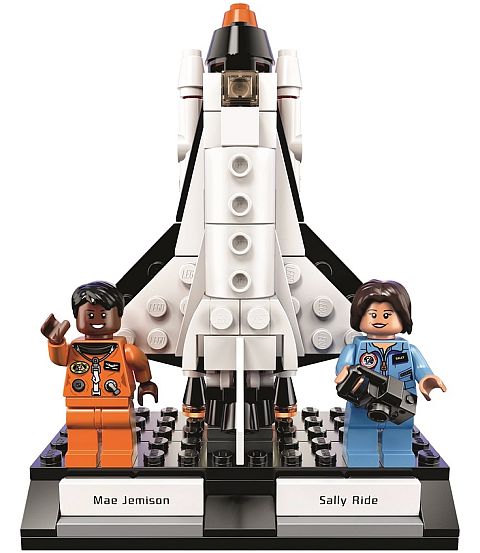
Sally and Mae are featured together in the largest vignette amongst the three included with the #21312 LEGO Ideas Women of NASA. Between their minifigures with included nameplates stands an awesome little Space Shuttle Challenger on a tiny launchpad. I lov this little ship! It just looks so nice and is quite swoosh-able! In fact, it even comes with three removable rocket stages! The two minifigs come in prints on both the front and back of their torsos, representing their spacesuits. I’m again very impressed with the very authentic facial features. Capturing real life people in minifig form is not easy. If they are too realistic, they end up looking creepy, or if they are too simple, they just look like generic cartoon characters. All four minifigures in this set are lovely and respectful representations of real people. Kudos to the graphic designers!
➡ LEGO IDEAS WOMEN OF NASA – NANCY GRACE ROMAN: Born in 1925, Nancy Grace Roman formed an astronomy club with her classmates at the age of 11. After graduating early from high school, she worked at several observatories while earning a Bachelor of Arts degree and a PhD in Astronomy. Throughout her education, she battled against the belief that women should not want to be scientists. In her late twenties, she discovered unusual behavior in the emission spectra of the star AG Draconis. She published her findings, becoming well recognized in the astronomy field. After working at the Naval Research Laboratory, she applied to the newly formed NASA and became the first Chief of Astronomy for its Office of Space Science, as well as the first woman to hold an executive position at the agency. She is most famous for her work in the planning of the Hubble Space Telescope launched in 1990, and is often called the “Mother of the Hubble”. She received the NASA Exceptional Scientific Achievement Medal in 1969, and even has an asteroid named after her!
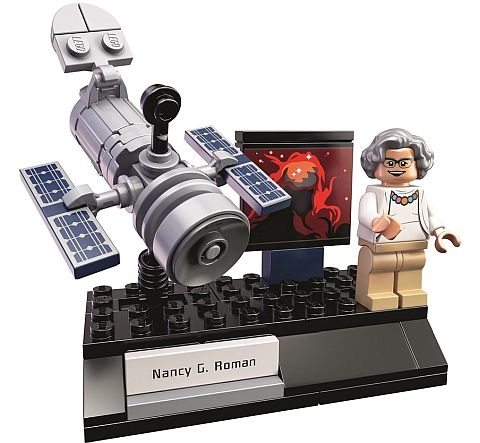
The Hubble Space Telescope vignette is my second favorite build in this set. It’s a fun little model with lots of greebling elements, including a repurposed garbage can. The 1×4 dark-blue tiles, the 3×4 panel (with a projected image of a planetary nebula), and of course her nameplate, are printed pieces. The only thing I don’t like about this vignette (and the only complaint I have about the entire set) is that the garbage can separates from the rest of the telescope quite easily. Surprisingly, it is the least secure connection of the Hubble Space Telescope, even though the pieces are attached with four studs. I attribute this to the softer, more yielding nature of modern LEGO pieces, which tend to not stick together as well as older LEGO elements.

The entire build took only about half an hour, but it was quite fun. There are no difficult building techniques, or too many complex steps, which makes this a perfect set for casual LEGO fans and young builders (the recommended age is 10+). The three vignettes look very nice, the minifigs are exceptional, and while the set is mostly meant as a display piece, both the space shuttle and the telescope are quite playable.
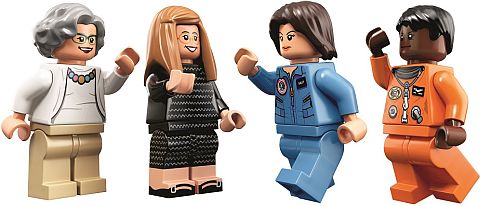
As far as interesting parts, there are some of those too. We already discussed the printed elements, which (besides maybe the nameplates) could be very useful in other applications as well. In addition, there are some nice small greebling pieces, like the 1×1 round plate with hollow stud in light-bluish-gray (you get four plus one extra), 1×1 rounded modified plate with handle (you get two in white), two black ice cream cones, three black cones (as thrusters for the Space Shuttle), two (plus one extra) watermelon slice tiles in light-bluish-gray, and 1×1 round plate with hollow stud and short bar at the side in black (you get one plus one extra). The minifigure parts also work nicely in other settings.
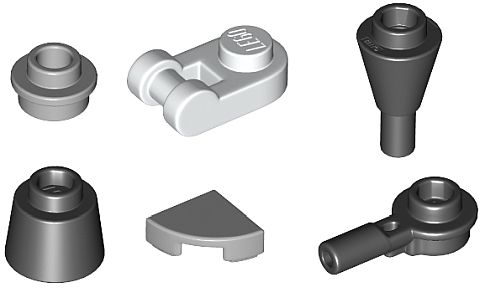
I did mention at the beginning that there are some controversies about this set. I’m not going to go into it in detail, as LEGO fans have talked about this at various forums and blogs, but the main issues people raise is that the set is more like a minifigure pack rather than a proper building set, and that it only highlights the achievements of female scientists, rather than just awesome people at NASA. I don’t feel qualified to analyze social and gender issues, however JANGBRiCKS addresses them well in the video-review below. And I can happily report that the set is definitely more than just a minifig pack. While the instructions are not difficult, you do end up building some nice models that look good on display and also have some play-features. For the audience that voted for this set, I feel like there is a perfect balance of educational value, playability and displayability. Building the set definitely inspired me to learn more about these amazing scientists and the work they have been involved with. Which is exactly what the original creator of the project, science editor and writer Maia Weinstock, wanted to achieve. If a LEGO set makes people learn, build, create, imagine, and talk about science stuff, that’s a good thing!
The first day the #21312 LEGO Ideas Women of NASA became available, social media channels were lit up with excited people who purchased the set right away. These were not just hard-core LEGO fans, but parents, teachers, scientists, journalists, and other people who appreciate the importance of scientific achievements and LEGO’s commitment to educational values. I think it was a good move from LEGO to produce this set, and it seems the general public agrees, as it is already shown as out of stock. LEGO is promising to make more though, so if you are interested, make sure you check regularly under the LEGO Ideas section of the Online LEGO Shop. This is a limited-edition set, so it won’t be around for long even when it gets back in stock again. (Picture below: Margaret Hamilton and Nancy G. Roman at the LEGOLAND Discovery Center in Boston, signing the set.)
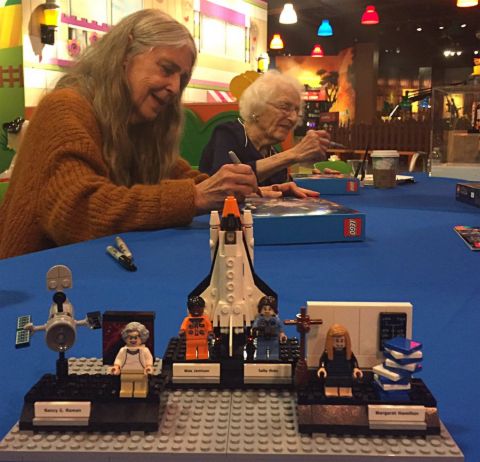
Here is the official description of the set: Explore the professions of some of the groundbreaking women in science, technology, engineering and mathematics (STEM) with the LEGO Ideas Women of NASA set. It features minifigures of 4 pioneering women of NASA— astronomer and educator Nancy Grace Roman, computer scientist and entrepreneur Margaret Hamilton, astronaut, physicist and entrepreneur Sally Ride and astronaut, physician and engineer Mae Jemison—and 3 builds illustrating their areas of expertise. Role-play space exploration from planning to moon landing, beginning with the iconic scene from Massachusetts Institute of Technology in 1969 of Hamilton with software that she and her team programmed. Build the posable Hubble Space Telescope and launch a LEGO version of the Space Shuttle Challenger with 3 removable rocket stages. The set also includes a booklet about the 4 featured women of NASA, and the fan creator and LEGO designers of this fun and educational set. Includes 4 minifigures: Nancy Grace Roman, Margaret Hamilton, Sally Ride and Mae Jemison. 231 pieces. Price: $24.99 – BUY HERE

What do you think? How do you like the LEGO Ideas Women of NASA set? Do you have it already? Or are you planning to get it? If you do have it, how did you like the building experience? Feel free to share your thoughts and own review in the comment section below! 😉
And you might also like to check out the following related posts:












I also ordered it as soon as I woke up on November 1. I’m going to keep mine sealed–for now, anyway.
I don’t get why it’s controversial. It’s not like they used Minidolls…
I think it’s a very cool set with very cool Minifigs.
LOL! Mini-dolls in this set would have made people hysterical! I also think it’s a great set, and very inspirational.
Spotted a typo: 19990
Thanks for catching that! It’s from the future! 😀
Thanks for listing some of the unique pieces. That makes the set even more interesting. I also don’t get why the controversy. Not every set has to have every age, gender, race, and political correctness thrown in there. These women did amazing things, so let’s just celebrate their achievements.
By the way, I like the signing picture at the end!
Yeah, it’s a nice picture I found on LEGO Ideas’ Twitter page. 🙂
Are they going to make more? I’m concerned.
Well, the hope is that they are going to make more. Unfortunately, it’s hard to tell, and I wouldn’t count on it. The LEGO Ideas Apollo Saturn V has been out of stock since it was released this summer, even though they said they are making more. The same thing happened with previous LEGO Ideas sets, including the Research Institute. So, if you do see the set elsewhere, and the price is not too outrageous, I would suggest getting it. And also check every few days at LEGO’s shop to see if they restocked. But the fact that they show the set as out of stock rather than backordered, means that they are at least a month behind in production. At least that has been my experience. 😐
Nice set, and for a good price. And I agree that it’s inspiring and a great conversation starter with kids.
I think it’s a decent set, and it does what its creator intended it to do: highlight women who played critical roles in NASA projects. But I think that a few aspects of the set could have been improved. Primarily, the rocket for the Challenger is ridiculously small. While that may have been reasonable in order to keep the size and price down, it just looks bad to me. The rocket should be 4X4 (and the side parts 2X2) and maybe 2 studs taller. The shuttle itself, however, is great and very detailed for the scale. Additionally, while I like the bases for the vignettes, as they look good and integrate the name plates and supports for the models well, they could have been smaller to save pieces for the models (like the rocket).
The Hubble vignette is my favorite, since the HST has a neat design. The trashcan is an excellent application, and it’s unfortunate that it has a weak connection. The 1X1 Round Plate W/ Shaft is a great inclusion as well; hopefully we’ll see it in many more sets. However, I have a problem with the “projected image” on the Hubble vignette. It may be greatly simplified, but I see very little resemblance to a planetary nebula. The Crab Nebula or the Pillars of Creation would have been better and more recognizable pictures to choose, even in simplified form.
Besides these relatively minor gripes, though, I think the set is good, and I’m not surprised it’s already out of stock. LEGO has been encountering this issue a lot lately…. 😕
Yeah, now that you mention it, the Challenger does have some tiny rockets. It actually doesn’t look that bad in real life, but it may have been because I’m happy to get those parts in black. I might experiment with making the rockets bigger, as you suggested.
That image with the Hubble vignette bothered me too, but I couldn’t really put a finger on it why. So I didn’t mention it. It actually looks like the genie in the Aladdin story; a big guy made of smoke with a turban on his head. Maybe it refers to a particular image, and it suppose to look like that, but I’m not sure.
And yes, so many desirable sets being out of stock doesn’t exactly make people happy. An even bigger concern is that it doesn’t seem like they are able to catch up. The Saturn V has been out of stock since this summer (with a couple of very brief windows of availability). That’s not good…
I’m guessing the black parts you refer to are the Fez’s, which are indeed new in black this year, and yes, it is good to get some. If you tried to upscale the rocket, I think my above dimensions are about right, but most of the parts needed for that are not available in Orange (or the more accurate color of Dark Orange), which is problematic.
That print looks like the Aladdin genie? I suppose there’s some resemblance, although I normally picture the genie in blue. It does not refer to any real image of a planetary nebula, of that I am pretty certain. The red background in particular confuses me: I don’t know if the black or the red, or neither, represents empty space. The inaccuracy to a recognizable object is odd for a set that’s supposed to teach people about space…. 😕
I’m thinking that LEGO will catch up with this set at least; it’s small and might receive less attention after a few months. The Falcon and Saturn V, on the other hand, are indeed sets LEGO is clearly having problems with. I do wonder if they could have not re-released the Taj Mahal and made extra production space for the Falcon.
Also, there are official images of four 2018 Juniors sets and this: https://brickset.com/sets/72003-1/Berserker-Bomber I was inspecting 72003 for new pieces (as usual), and I found a few new pieces. One is a black 4X4 plate with a bow that curves inwards. They’re on either side of the cockpit (and one per wing). The Tech Critter is interesting; I have to wonder if that Tr. Bright Green stud is part of the mold, or inserted during construction. I note the box shows them being launched from the back, even though they attach on the top. But this means we’re finally getting images of 2018 sets; hopefully there’ll be some more interesting sets than what we have thus far….
I was just looking at that Berserker Bomber earlier today! It looks rad! So many interesting parts! My guess would that that the stud on the Tech Critter thingy is removable, but it could also be part of the mould, as you said. And yes, I can’t wait for more pictures! I’m especially curious to see what the next Modular is going to be. 🙂
P.S.: Also good point about the Taj (which nobody really asked for) possibly taking up production space from the Falcon and the Saturn V. They consistently say that their machinery runs 24/7.
The biggest controversy is that this set has minifigs instead of minidolls. It is marketed towards girls and women but Lego has told us over and over again that females hate minifigs and will only like minidolls.
Hm… that sounds like a misunderstanding. LEGO did not say girls hate minifigs. There have always been female LEGO fans of all ages who are very much in love with minifigures. However, still, it was an undeniable fact that most kids interested in LEGO have been boys, and LEGO was trying to figure out why girls were not as attracted to the LEGO building system. Through their extensive research and testing with real children, they discovered that most young girls preferred story-based sets, and characters that are more human-like. Thus mini-dolls were born.
LEGO’s research was obviously correct, as the LEGO Friends, LEGO Elves, and other mini-doll based sets are some of the most popular lines LEGO ever released, bringing in a huge number of young fans who were previously never interested in LEGO. LEGO continues to make both minifig-based sets for both boys and girls who prefer traditional LEGO figures, and mini-doll-based sets for fans who prefer mini-dolls. There is something for everyone. 🙂
As far as the LEGO Ideas Women of NASA set, the original creator of the set is a LEGO fan herself, and she choose to use minifigs. If she would have chosen mini-dolls, and the project still reached the required number of public votes, I’m sure LEGO would have stayed with her choice, as they try to remain as faithful to the original designer’s submission as possible. 🙂
Minifigs are aimed at girls, mostly. Adults of either sex, which is a large part of the audience, often prefer minifigs for nostalgic reasons.
Minidolls are aimed at young girls, I mean.
And this set isn’t primarily aimed at young girls, the target audience is different.
Yes, that’s also true. But I’m also certain that if Maia would have wanted mini-dolls to go with her set, and it still reached 10K votes, LEGO would have gone with that.
Yes, that’s a very good point too. Minifigs are what people associate with LEGO and there is a lot of nostalgia involved, especially for older people who grew up with LEGO.
As I have mentioned in one your earlier blog, the problem is that the original set was a minifig set. The released set is not but that’s because of the significant changes LEGO designers made to it. ( I am the one that question whether this set should still be labeled an IDEA set.)
The most significant change I see is that Katherine Johnston and her vignette was removed. Otherwise, I can’t see any major differences.
Yeah, that’s pretty much it, and combining Maia’s original frame with the name-plates into the vignettes themselves.
The shuttle and telescope is significantly different than the original. The final result is much more interesting. The original IMO is just an accessory for the minifig. Hence why I called the original set a minifig set.
The telescope, especially, is a significant improvement from the original. It’s basically a lot more fun and interesting. I would add though that both the telescope and the shuttle include new pieces that were not available when the project was originally submitted.
Maia did include some small vignettes with her original submission, and they are almost identical to what was released, besides some changes to the building techniques. She did include the small Challenger, the Hubble Telescope, and the stack of books with Margaret. The only major difference is that Maia also included a separate frame, where all the minifigs can be displayed with their names and without the vignettes. LEGO combined the two ideas and instead included the name-plates on the vignettes themselves and added a more substantial base to each. I didn’t show this in my review, but the vignettes can be put in a row, to give a similar effect as Maia’s original frame. I think it’s really nicely done.
The other major difference is that Maia also had a vignette with Katherine Johnson. Katherine didn’t want to be in the set (or perhaps she couldn’t, because of the recent movie about her), so LEGO had to take her out.
LEGO designers work closely with the original creator to make sure everyone is happy with the final result. LEGO Ideas projects are sort of a co-creation between the original submitter, supporters who give suggestions for improvements (updates are allowed on all projects), and LEGO’s own designers. At least in my opinion, LEGO has been pretty good at respecting the wishes and ideas of the original creator and those who voted for the project.
I was a little surprised to see this set this morning at the local Bricks and Minifigs store. They wanted $35 which is still cheaper than pretty much anyone on ebay. Currently someone has 231 sets they’re selling on ebay. Lego maybe might wanna limit that number on ideas, maybe, unless there is some other way someone got that many.
Rob, wow! That’s disturbing. 231 sets???!!! It’s really not possible to legally buy that many sets directly from LEGO, as they do have a limit, and they are very strict about not selling to resellers. That eBay seller seems to have found some kind of a loophole.
Also, it’s possible it could just be a scam… =/
Yeah, that too. Although that could be easily detected by their feedback. If they have been a member for a long time, and have a good number of feedback, it’s probably not a scam. Also, scammers usually list their stuff cheaper than everyone else, so they can get money quickly. It’s a dangerous world out there. 🙄
Both of you make good points. Here is the listing on ebay:
https://www.ebay.com/itm/LEGO-21312-Ideas-Women-of-NASA-231pcs-New-In-Hand-Free-Shipping/142572997528?epid=16007622942&hash=item2132034b98:g:40IAAOSwYc5aBHT5
Derp! I was reading the /parts/ number not the number of sets. But they do have quite a pile there! 😀 A good 50 plus.
That’s still a huge pile. LEGO does restrict sales to around five or so, even if there is no limit listed. However sometimes people get around this by paying with cash and keep going back to the store, or sending friends/family members to get more for them.
The interesting thing about this listing is that their price is only $50 with free shipping. If they bought these sets from LEGO at the regular price of $25, they are only making about $8.50 profit per unit. Of course, people have different standards, but to me, that doesn’t seem to be worth the hassle, especially since they live in New York. They are making around $470 on that pile (if they sell all 55 units at the current price), and that doesn’t include labor and packaging cost.
That does seem like a lot of effort for a fairly small gain on “investment”. Be interesting to know what they seller is thinking, though the thought crossed my mind possibly to ‘beat the scalpers at their own game’ and sell a bunch of them to buyers at a more obtainable price. One of life’s great mysteries, I suppose! 🙂
That’s possible. Maybe he is the Batman of LEGO resellers. 😀
55 boxes, if I’m correct…
The controversy is that this is just a glorified battle pack,…which is against the rules for LEGO ideas.
Hm… maybe. Although you could say the same about the Research Institute, which didn’t get nearly as much flack as this one. LEGO makes the rules, so they can interpret them however they want. 😀
I recall that Research Institute, at the time, got pretty much flack for being a minifig pack, as well as for the gender issues.
I remember that as well. The set still sold out in the blink of an eye. There are always those who will complain… Just look at Friends. It is one of LEGO’s most successful product-lines, and kids love it. But some people still say Friends should have never happened… 😐